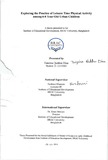| dc.description.abstract | Children's regular participation in physical activity has multiple benefits to children's
physical and mental health. Not only this, physical activity is identified as one of the
basic preventive measures for non-communicable diseases where younger generation of
developing countries are more at risk than that of developed countries. There is also a
growing trend of physical inactivity among the urban population where half of the
children population live as well. In case of Bangladesh one third of the total urban
population is children and alarmingly, children living in urban areas of Bangladesh are
also found to adopt more inactive lifestyle day by day. Still the scenario is not same for
the children belonging to different social classes. Parents' perception, parental role,
opportunities to play outdoor, neighborhood environment, academic pressure were some
of the significant influencing factors in children's participation in physical activity
identified by different studies. However, many developed countries have already
developed effective intervention programs to ensure children's regular participation in physical activity at all levels. Contrary to that Bangladesh is far behind in adopting the
'best practice' towards physical activity interventions. Considering the overarching benefits of physical activity for children's development and
the need for exploration on this issue in the context of Bangladesh, the present study was
conducted with an aim to explore the practice of leisure time physical activity among 6-8
year old urban children living in Dhaka. The objectives of the present study were to
explore the practice of physical activity among 6-8 year old children in urban Dhaka and
to identify the factors influencing children to be engaged in physical activities. The study was an exploratory research. Data was collected through qualitative methods.
It used two different data collection methods- one was observation of children and
another was in-depth interview of parents. Tools used in this study were a semi
structured interview questionnaire for parents' interview, a child's interview schedule
and an observation guideline for observing each child. The study followed purposive
sampling where four 6-8 year old school going urban children of Dhaka were recruited
as research participant. Two were from low income group and two were from middle
income group. In each group one was male and another was female child. Content
analysis was followed in analysing the qualitative data. The analysis of the data of present study shows that, the practice of leisure time physical
activity among 6-8 year old living in urban Dhaka largely varies according to their
gender and family income. Male respondents showed more play based physical activity
than their female counterparts. For the children from low income group participation in
physical activity was included in their lifestyle as a daily routine. On the other hand for
the children from middle income group participation in physical activity was optional
and it was more like a recreational activity than a routine work. And participation in
physical activity was higher for children from low income group than middle income
group. Factors which were positively related with children's physical activity
participation were parents' encouragement, involvement in children's physical activity,
presence of a favorite peer, parents' facilitation in case of male child. On the other hand
parents' perception about neighborhood, academic pressure, lack of adult role, parents' emphasis on food habit and academic work were some of the impediments towards
children's participation in physical activity. Apart from this, outdoor and indoor
facilities seemed to be less influential as the existing social environment had greater
impact. The study revealed that the practice of leisure time physical activity among the 6 to 8
year old children living in Dhaka seems to follow a distinctive pattern where family
income, gender, parental influence, parents' perception about neighborhoods, peer,
academic pressure, played key influential role. Finally, it can be recommended that
objective study on larger population need to be conducted to determine the actual amount
of physical activity, the problem needs to be addressed at policy level and there is also a
need for advocacy for a neighbourhood environment that is safer and more accessible to
children. | en_US |

